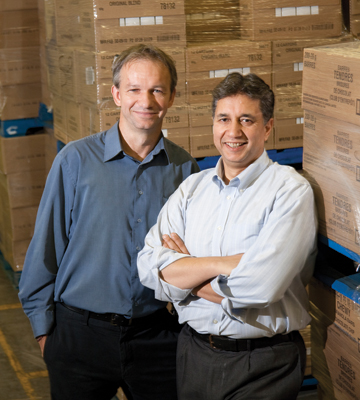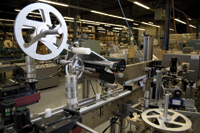
The sum of all parts
By Andrew Joseph, Features Editor
Automation Converting 3PL Converting packagingDoing many things right keeps Canadian co-packer focused on future growth
Some companies pride themselves on quality of their work; others on their fast turnaround. But for Britman Packaging Services, being good and being fast are both tightly intertwined core competencies that have kept the thriving co-packer of food, personal-care and other packaged consumer goods going from strength to strength since it was founded in Oshawa, Ont., back in 1961.
“The only way to run a successful business for nearly 50 years is to ensure that we understand the customers’ needs well and satisfy them to the best of our ability,” says Farhat Buchh, president and co-owner of a division of Britman Industries that today operates out of a state-of-the-art, 47,000-square-foot facility a short drive east of Toronto in Ajax, Ont., where it relocated in 1993.
“I know that almost every company one talks to is going to say they are ‘customer-focused,’ and while I can’t speak for anyone else, Britman certainly is,” states Buchh, who took over the company in 1998 and, despite the recent economic recession, saw Britman build up on its hard-earned industry reputation as a reliable, customer-centric provider of third-party packaging services to many types and sizes of consumer goods manufacturers and brand-owners.
“It’s not enough to just say you are customer-focused; it’s all about actually putting it into practice,” Buchh told Canadian Packaging during a recent visit to the Ajax operation. “And it’s not something just for myself and my staff—it is understood and followed by every member of our team, the maintenance staff, floor workers, everyone.
“We can only be a great company if everyone works together with one common goal,” Buchh asserts, “and that is why we have the expertise to provide customers with the right solutions for all their packaging needs.”
Plant manager Ray Grzesik estimates that pharmaceuticals, personal-care products and dry foods account for about 80 per cent of the plant’s co-packing business—citing products such as gum, mints, candies, granola bars, rice, oatmeal, cereals and tea, deodorants, body washes, soaps and toothpaste—with some cosmetics, automotive parts and plumbing fixtures making up the rest of production.
“We certainly do not limit ourselves to what we can package for our customers,” Grzesik relates.
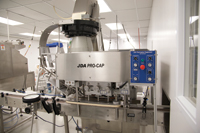
One of the two packaging lines inside the 10,000 Class cleanroom uses a JDA Pro-Cap 5000 capper for packaging candies inside metal tins and containers.
“If it can be packaged, we will find a way to do it for them,” says Grzesik, stressing that the company works just as hard on behalf of its multimillion-dollar, multinational clients as it does for the smaller local manufacturers looking for some outside packaging expertise and know-how to get a leg up in the marketplace.
“Being located on the eastern side of the GTA (Greater Toronto Area) region, we are in great position to service companies located in this area, and the easy access to Highway 401 allows us to efficiently cooperate with companies located west of Toronto as well,” Grzesik notes.
Go west
“But as part of improving our service even further, Britman is now looking into extending its operations into the western side of the GTA region in the near future.”
In addition to doing the actual packaging work for them, the company also offers its CPG (consumer packaged goods) customers considerable expertise in the area of packaging development and design, according to Buchh and Grzesik.
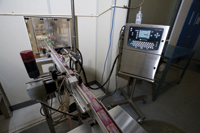
Packages of candy whisked from the 10,000 Class cleanroom pass by the Domino A100+ inkjet coder for quick printing of all the required product codes and data.
“We often get customers who have a newly-developed product come to us saying they have no idea how to create a package for it, or what processes and equipment should be used to package it,” Grzesik relates.
“So we work with them and develop an effective package, using outside graphic services providers to create any required graphic elements, and an effective packaging process for bringing it to life,” explains Grzesik. “Our technical expertise and capabilities allow us to propose, source and provide integration of the packaging line without using outside technical services.
“We really are a one-stop packaging shop.”
Adds Buchh: “A lot of the co-packing we do is taking product that is already primary-packaged and placing into a secondary packaging—the outer packaging that protects the product as it sits on a store-shelf awaiting purchase—but we also provide primary packaging services.”
Most of the products handled at the Britman facility get shipped out at most within days of being packaged, relates Buchh, citing one large Fortune 100 customer who sends four to eight rucks to the plant daily to move products in and simultaneously pick up the packaged goods for delivery to its distribution centers.
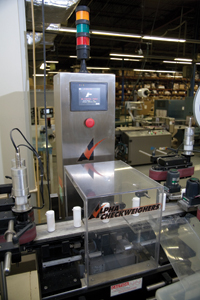
After coding, products transferred from the cleanroom are weighed by an Alpha checkweighing system supplied by All-Fill Inc.
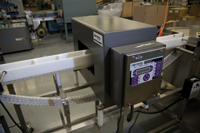
The vibratory feeding system working with the JDA Pro-Cap 5000 capper incorporates several Omron photoelectric switches.
Thriving in such a fast-paced environment is all part of what makes the company tick, according to Grzesik, who has been with Britman for over 19 years.
“It’s always busy in here—we currently run two-eight hour shifts a day, five days a week,” he relates. “But in all my time here, we never missed a deadline and we’ve never had a customer complain about our turnaround times.
“We always make time to understand what is important to our customer,” Grzesik explains, “so that we can tailor our services to achieve the results they desire.
“But to make it all happen,” he adds, “it is key that we have the equipment and the facilities to allow us to perform to the best of our abilities.”
To that end, Britman had made significant investment at the Ajax facility to install two specially-designed, controlled-environment cleanrooms—a 100,000 Class and a 10,000 Class cleanroom—for packaging products with extremely strict required limits for airborne particles.
(Compared to a typical office environment containing on average anywhere between 500,000 and a million 0.5-micron or larger particles per cubic foot, the 100,000 Class cleanroom is designed to lower the particles count to less than 100,000 particles per cubic foot, and a 10,000 Class cleanroom to less than 10,000 particles.)
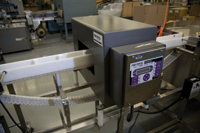
All the labeled packages pass through a high-accuracy Phantom metal detection system from Fortress for a final quality assurance check.
“It’s a level of product safety we put in to ensure our customers feel safe about allowing us to do their food-grade primary packing,” explains Buchh, citing Britman’s unwavering commitment to quality control that enabled it to obtain Health Canada’s Drug Establishment Licence, as well as a NHP (natural health product) Licence.
The 10,000 Class cleanroom is equipped with a model Slatmaster tablet and capsule filler—manufactured by Speck-Tech Systems Inc. of Gormley, Ont.—used primarily to count and fill plain and coated candy, mints, and hard and soft gelatin capsules into containers or pouches.
“This filler provides us with fast, accurate and trouble-free operation,” explains Grzesik. “The equipment has been designed for gentle product handling from the feed-hopper right to the chute, which significantly limits product breakage.
“And since it is located in a cleanroom, it is also very easy to clean and sanitize—which is important for eliminating any risk of product cross-
contamination,” he adds. “The same applies to all other food packaging equipment at our facility.”
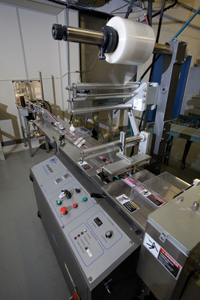
After weighing and coding, filled conainers move towards a flowwrapping system made by PFM Packaging Machinery.
The Slatmaster works in conjunction with the model JDA Pro-Cap 2 capping machine supplied by JDA Packaging & Processing Equipment (JDA), Concord, Ont.-based manufacturer of high-performance packaging and filling systems and equipment.
After the product is filled and capped, the packages are moved outside the cleanroom via a conveyor system to an Alpha checkweigher—manufactured by the Exton, Pa.-based All-Fill Inc.
Controlled by an operator-friendly touchscreen panel that can be set up for weight parameters of up to 50 different products in various container shapes and sizes, the Alpha checkweigher features an automatic rejection capability to remove any out-of-tolerance containers right off the line.
From there, all the accepted packages have labeling applied via a model Pro-Label applicator from JDA and go through a final safety scan performed by a high-accuracy, high-speed Phantom metal detection system from Fortress Technology Inc., featuring cutting-edge digital signal processing technology.
Metal mettle
The second packaging line configured in the same the cleanroom—mostly used to count and pack candy mints into metal containers—consists of a PCL 80/167 electronic counter supplied by the Toronto-based Pharmaland Technologies; a JDA Pro-Cap 5000 capper that utilizes a Festo ‘pick-and-place’ pneumatic system; and a vibratory feeding system from Automation Devices Inc. of Fairview, Pa., which uses Omron’s E3A2-XCM4D photoelectric switches and other electronic controls.
After the product is fully packaged, it is conveyed outside the cleanroom—passing by a Domino A-Series plus continuous inkjet coder that adds a best-before date and lot coding information—and through a two-motor flowwrap packaging machine, supplied by the Newmarket, Ont.-based PFM Packaging Machinery Corporation North America, before its final sealing by the shrink-tunnel.
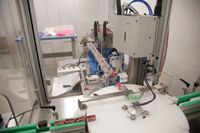
Located inside the 10,000 Class cleanroom, the JDA Pro-Cap 5000 capper employs a pneumatic pick-and-place system supplied by Festo.
The packaging systems used inside the cleanroom are part of an impressive packaging equipment arsenal housed throughout the Britman facility, which also includes:
• a B1-ML manual loading cartoning system from Langen Packaging Group Inc.;
• a Little David Microjet inkjet printer built by Loveshaw, and distributed by Dependable Marking Systems Ltd. of Oshawa;
• a B-44 sleevewrapper from Damark Shrink Packaging Systems;
• models A100 and A200 coders from Domino;
• an automatic shrinkwrapping system from RBS Equipment Designs Ltd.;
• an Autocheck 4000 checkweigher from Ramsey Icore;
• a high-speed Doboy Stratus horizontal flowwrapper from Bosch Packaging Technologies;
• a model CF-1 shrinkwrapper from Shanklin Corporation;
• an Alloyd blister-packing machine;
• a weighfiller from Actionpac Sales & Automation;
• an Econoseal Spartan horizontal mechanical cartoner from Econocorp Inc. to erect, load and securely seal loaded shipping cartons with hot-melt adhesive.
“It’s not just one thing that has enabled us to become a successful company, but rather lot of different things that we do well,” Buchh sums up.
“We have found that if we can focus on the four key elements of technical ability, quality control, speed and customer focus and do well with each one, we will continue to grow our business.”
Advertisement


